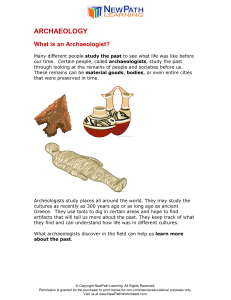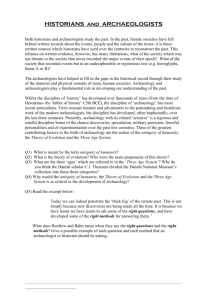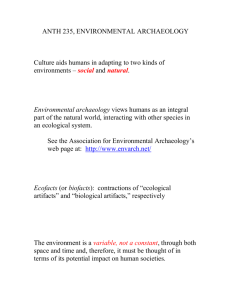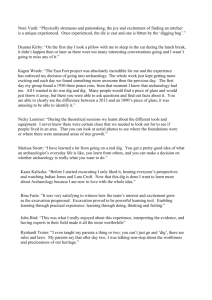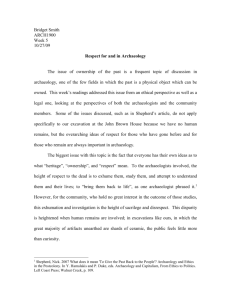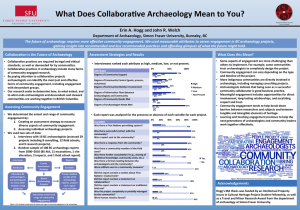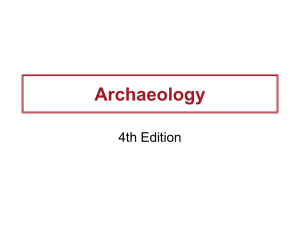BIG 6 – DIG IT - OMS Media Center
advertisement
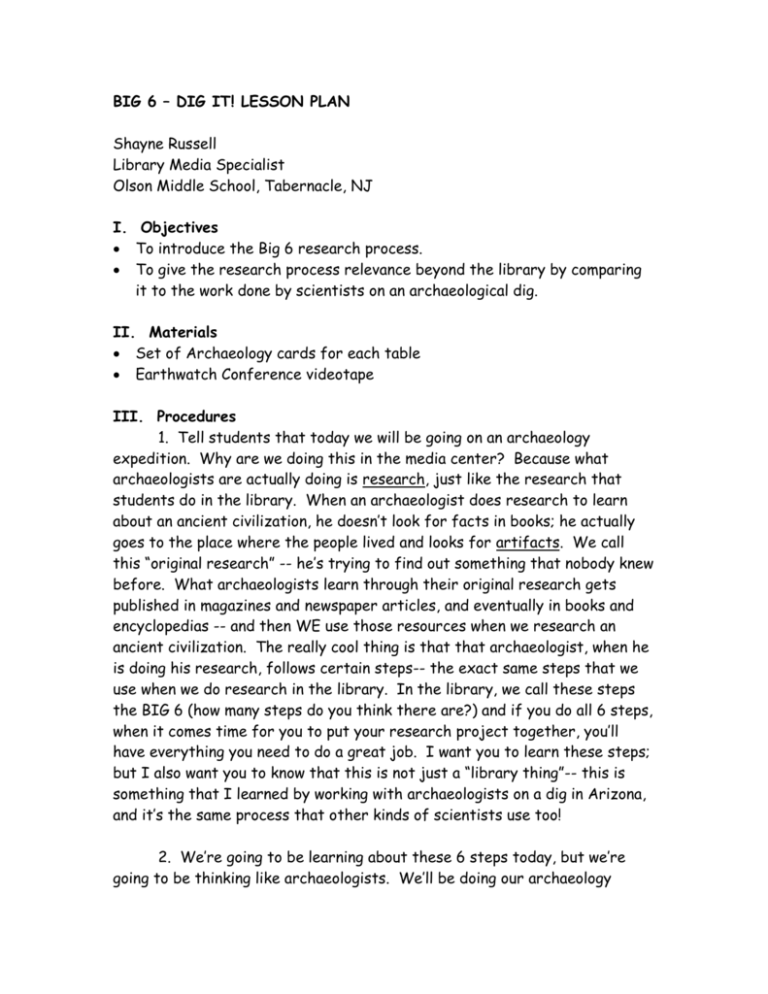
BIG 6 – DIG IT! LESSON PLAN Shayne Russell Library Media Specialist Olson Middle School, Tabernacle, NJ I. Objectives To introduce the Big 6 research process. To give the research process relevance beyond the library by comparing it to the work done by scientists on an archaeological dig. II. Materials Set of Archaeology cards for each table Earthwatch Conference videotape III. Procedures 1. Tell students that today we will be going on an archaeology expedition. Why are we doing this in the media center? Because what archaeologists are actually doing is research, just like the research that students do in the library. When an archaeologist does research to learn about an ancient civilization, he doesn’t look for facts in books; he actually goes to the place where the people lived and looks for artifacts. We call this “original research” -- he’s trying to find out something that nobody knew before. What archaeologists learn through their original research gets published in magazines and newspaper articles, and eventually in books and encyclopedias -- and then WE use those resources when we research an ancient civilization. The really cool thing is that that archaeologist, when he is doing his research, follows certain steps-- the exact same steps that we use when we do research in the library. In the library, we call these steps the BIG 6 (how many steps do you think there are?) and if you do all 6 steps, when it comes time for you to put your research project together, you’ll have everything you need to do a great job. I want you to learn these steps; but I also want you to know that this is not just a “library thing”-- this is something that I learned by working with archaeologists on a dig in Arizona, and it’s the same process that other kinds of scientists use too! 2. We’re going to be learning about these 6 steps today, but we’re going to be thinking like archaeologists. We’ll be doing our archaeology expedition in Arizona and since we’ll be talking archaeology today, I want to start by showing you a short video of the site where we’ll be working. (View video) 3. Try to re-organize students so there are 6 students at each table. Give each table a set of Big 6/Archaeology cards. Explain that there are 6 different cards and each one represents one step of the Big 6. The name of the step is in capital letters on the card. Some of the steps have big scary names, so I looked up some of the words for you. Your first task is to work with the people at your table to figure out which order the steps go in. If you were an archaeologist, what would you do first? Which is step one, which is step two, etc.? Remember to think like an archaeologist-- both archaeology and research are kind of like solving a puzzle, and you need to use all the clues available to you. The names of the steps might be clues that could help you. Once you have the steps in an order that makes sense to you, talk with your group about what these 6 steps might look like if instead of doing research as part of a team of archaeologists, you were doing research as a group of students in the media center. I should be hearing things like, “oh-- what they’re doing there is just like taking notes” or “ that’s kind of like writing a bibliography” or “we might be using tools like the online catalog or book indexes to find our information.” You don’t have to write those things down, just remember them so we can talk about them together. Depending on time, try to allow groups about 15 minutes to work together. IV. Culminating Activities First let’s try to get the steps in the right order, then we can talk about what they would look like when we do them in the library. It might have been easier to figure out where to put some steps than others. Which do you think is the last step? Which step would be a good first step? If you have a SmartBoard, students can physically move the steps into the right order using this webpage: http://home.earthlink.net/~s.russell/big6/big6.html As a group, go over the order of the steps. Discuss what occurs during each step and what students would be doing in the media center during each step. Have students make notes on their worksheets: Emhasize these things… Step 4: Only put in your notes what answers your question in Step 1! The rest is "dirt". Step 5: Synthesis = putting parts together to create something new. Something that is uniquely your own that has not been copied from some other resource! Discussion of steps: 1. Task Definition: Knowing exactly what the assignment is. Deciding on a topic. Narrowing down the topic. Deciding what question you want to answer in your report. (A thinking step) 2. Information Seeking Strategies: Thinking about all the possible places you can look for your information (books, magazines, newspapers, videos, reference books, encyclopedias, CD-Roms, the internet, ask an expert). Then deciding which would be the best place to start. Trying to plan and save yourself time. (A thinking step) 3. Location and Access: Actually getting your hands on the sources and looking for information in them. For instance, using the OPAC to find a book. Using the index to find the specific information you want in that book. Selecting the World Book on CD-rom. Doing a Boolean search to get to the facts you’re looking for. 4. Use of Information: This is where you actually interact with the information. If it’s a book, you read it. If it’s a video, you watch it. If it’s a person, you ask questions. And while you’re doing this you’re watching and listening for facts that help to answer the question you decided you were trying to answer in Step 1. You put those important facts in your notes. It’s like sifting through the dirt to find artifacts-- anything that doesn’t help answer your question is dirt-- it doesn’t go in your notes. And you keep track of where you found the facts that go in your notes. 5. Synthesis: You get all your notes and facts together and get them organized so you can do something with them. You might have them on index cards and sort them into piles, you might use a graphic organizer, you might write an outline. But you’re getting them ready to make something out of them. Then you decide what you’ll make-- how will you present your information? A written report, a speech, a webpage, a slide show, a model? You have to decide what would be the most effective way to share what you learned with other people. And you need to write a bibliography so that people will know where you got your information, and where they should go if they want to learn more about your topic. They could look at the same sources you used. 6. Evaluation: You admire your work! You decide if you answered your question. You think about if you did the best you could. You think about what worked well, that you would do again next time, and what didn’t. This will save you time the next time you have a project to do, and will help make you a better researcher. (A thinking step) There are 6 steps to the Big 6-- 3 of the 6 are thinking steps. You are really only working half the time and just sitting around thinking the other half! How bad can it be?! V. Assessment During this lesson: Are students able to make the connection between the Big 6 as related to archaeology and what they would be doing in the Media Center? In the future: Will students make sure they actually understand an assignment before starting it? Will students take the time to think and define a topic before starting a research project? Will students begin to use resources other than encyclopedias to find information? Will students, upon completion of an assignment, check to be sure they have actually done what the assignment called for? VI. Core Curriculum Standards Information Power Standard 6: The student who is an independent learner is information literate and strives for excellence in information seeking and knowledge generation. NJ Science Standard 5.1, B1: Develop strategies and skills in information-gathering and problem-solving using appropriate tools and technologies.
